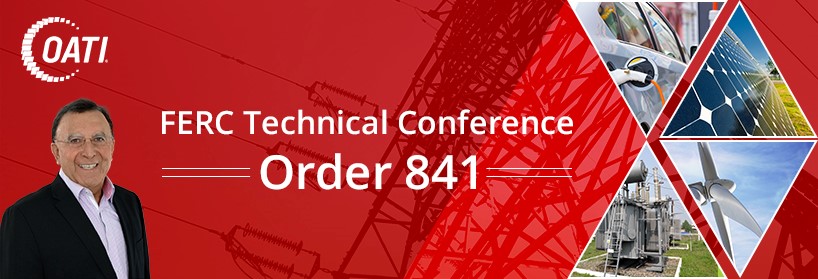Home » Blog » Grid Modernization » Dr. Ali Ipakchi Highlights Takeaways from April FERC Conference Panel
Dr. Ali Ipakchi Highlights Takeaways from April FERC Conference Panel
In response to the Order 841 issued in February regarding Electric Storage Participation in RTOs and ISOs, FERC held a conference April 10-11, 2018 in Washington D.C. to focus on Distributed Energy Resource (DER) aggregation participation. As a panelist, Dr. Ali Ipakchi, OATI Executive Vice President, participated in this discussion and in more broad considerations of the potential effects of DERs on the bulk power system.
In this blog, Dr. Ipakchi shares his four takeaways on the event: the need for visibility, current DER aggregation practices, lessons from FERC Order 888, and integrated EMS-DMS to address DER needs.
Leverage New Technologies for Real-Time Visibility
In response to the Commission’s question of what real-time data acquisition and communication technologies are currently in use to provide bulk power system operators with visibility into the distribution system, Dr. Ipakchi commented that traditional Supervisory Control and Data Acquisition (SCADA) systems used in transmission and distribution systems may not provide the scalability and economics needed for real-time visibility into expanding levels of DERs. Rather than looking at traditional models, the industry can leverage new technologies while adhering to cybersecurity and information privacy protection measures.
Visibility to the current and the near future grid operating conditions is essential to properly manage the power system. The overall importance of real-time information was stressed at the conference, as well as the need for cost-effective, reliable but forward-thinking technology.
DER Aggregation: G&T Companies
With respect to issues associated with DER aggregation, Dr. Ipakchi commented that currently Generation and Transmission (G&T) companies successfully aggregate resources from their member companies (Co-ops) for scheduling bulk power supply and energy market operations. G&Ts have established effective methods for management of member company assets, scheduling, dispatch and settlements.
Applying Lessons from FERC Order 888
Regarding the question of whether a common model for DER aggregation and market operation can be adopted across the nation or if regional models are needed, Dr. Ipakchi asserted that some of the lessons learned from FERC Order 888 on interstate transmission of energy in wholesale bulk power might be useful to consider. For example, some of the processes and concepts for capacity reservation and scheduling established following the 888 order, like E-tagging and OASIS, might be applicable to the DER operation. However, they may have to adapt those lessons to support distribution and DERs, in contrast to transmission and bulk generation.
Addressing DER Needs: EMS-DMS
There was also a question from FERC if utilities should consider an integrated Energy Management System-Distributed Management System (EMS-DMS) to address DER needs, especially for the incorporation of distribution-level DERs into bulk power operations. Dr. Ipakchi responded that it might be more effective for utilities to first consider the addition of a DER Management System (DERMS) to include modeling of DERs and secondary distribution circuits where they are located. A DMS generally does not model the tariff/cost parameters needed for scheduling customer-owned DERs which is essential for the integration of DERs with market operations.
There was also an expressed need for a lot of work on the part of ISOs and RTOs and a desire for guidance from FERC, especially for markets developing critical processes and frameworks for information sharing and resource control.
About the Author
Dr. Ali Ipakchi has more than 38 years of experience in information technology applications to power systems and electric utility operations. As the Vice President of Smart Grid and Green Power at OATI, he is responsible for product design and development as well as business growth in the Smart Grid area.
His areas of experience include utility and power systems operations, enterprise and operational IT systems, utility automation, systems for ISOs/energy markets, utility control centers, trading floors, power generation, distribution operations, distributed and renewable resources, and advanced metering. Dr. Ipakchi has been an active member of various industry forums including the NEASB Smart Grid task force, NIST SGIP, OpenSG and a number of other industry initiatives for demand response, smart grid, interoperability standards and grid modernization.
- May 1, 2018
